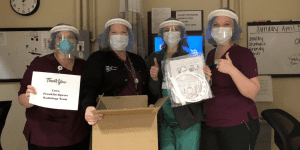
UMBC and DARPA Advance Briefcase-sized Drug Factory to Produce Medicine On-demand
November 13, 2019
In 2013 the University of Maryland Baltimore County (UMBC) was awarded a $7.9M contract from Defense Advanced Research Projects Agency (DARPA) to come up with a more efficient way to develop drugs. If successful the new system would, “completely revolutionize the manufacture of biologics,” according to Govind Rao, the principal investigator, and director of UMBC’s Center for Advanced Sensor Technology said the technology.
Six years later Rao and his team are closer to making this Star Trek-esque concept a reality.
The goal of the program is to invent a system that will condense the equipment and processes needed to develop protein-based drugs from a large bioreactor that takes weeks to a briefcase-sized platform that can make drugs in a matter of hours.
Small scale production capabilities such as this would make drug manufacturing portable and more accessible to many patients who do not have access to medicines such as through remote hospitals that do not have the same supply chain of medicines that are available in many urban centers. The system would also drive down production costs making medicine more affordable and on-demand. This type of technology could be a major disruption to the biomanufacturing industry as we know it.
The system is called Bio-MOD, or Biologic Medications on Demand, and a former DARPA program manager likens the technology to that of 3D printing as described in a recent Nature article titled – Who shrank the drug factory? Briefcase-sized labs could transform medicine.
Similar point-of-care approaches are being developed to automate and close the biological production processes for cell therapy. Miltenyi’s CliniMACS Prodigy® is an all in one automated T cell expansion and purification system. If successful, Prodigy® could bring an end solution that would eliminate the complicated supply chain and cleanroom production facilities by simplifying the whole manufacturing process right at the point of care. There is a lot of progress needed to make this a reality, but Miltenyi is at the forefront of making this vision a reality.
In 2015 UMBC received another $8M grant from DARPA to take the technology right up to the point of clinical trials, and they have made substantial progress. According to the recent Nature article, ‘Rao’s system made GCSF that was just as pure as commercially available products (R. Adiga et al. Nature Biomed. Eng. 2, 675–686; 2018). Subsequent tests in animals, not yet published, showed that it worked just as well, too.’
In addition to UMBC, who is the lead of a consortium working on this program, the Ohio State University (protein purification), Thermo Scientific (cell-free expression system), and Latham BioPharm (system integration) are all involved in making what was once the type of idea reserved for science fiction, now become a reality.
Read the full Nature Article Here.
- About the Author
- Latest Posts
Over the past 11 years, Chris has grown BioBuzz into a respected brand that is recognized for its community building, networking events and news stories about the local biotech industry. In addition, he runs a Recruiting and Marketing Agency that helps companies attract top talent through a blended model that combines employer branding and marketing services together with a high powered recruiting solution.





